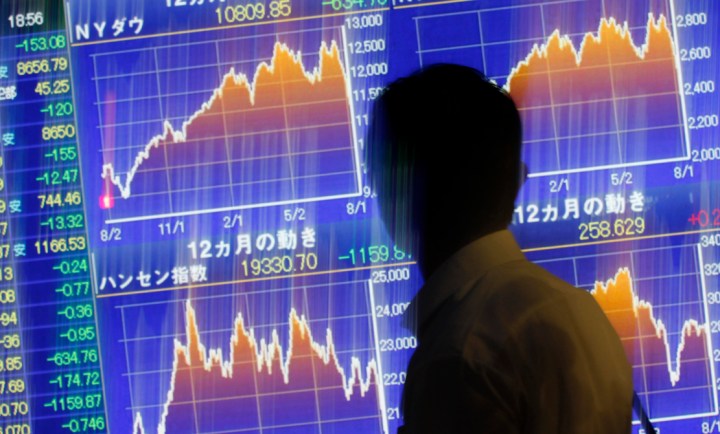Business Maverick
The Dow Jones Industrial Average: An instructive history

It’s the stock market index watched most closely by the media and the general public, and over the last week, reacting to the sovereign debt crises in Europe and the US, it has set records for consecutive daily movements. But what’s the history of the Dow Jones Industrial Average? If you’re invested in US equities right now, maybe you can take some comfort from the words below. By KEVIN BLOOM.
On Thursday, 8 May 2010, the Dow Jones Industrial Average suffered its biggest loss ever during a trading day. In just under 30 minutes the index plummeted 1,000 points, shedding almost 10% of its value. Earlier in the day, while traders sat watching television coverage of protests in the streets of Athens, the Dow had lost 200 points on fears that the Greek debt crisis would scupper the economic recovery. At around 2.40pm it was off 400 points, at 10,460. Then it tumbled a further 600 points in seven minutes. By 3.09pm it was back up 700 points, and the trading day ended at 10,520. Some traders, according to the Associated Press, had been knocked off their chairs by the wild swing. At one point, Procter & Gamble, generally a stable stock, was 37% down on its opening price.
Why the unprecedented plunge? Nobody knew for sure. There was speculation that automated orders activated erroneous trades, but the New York Stock Exchange said there was nothing wrong with the Big Board’s systems. Some believed that a trader placed an order for $16 billion worth of futures instead of $16 million, and that the mistake triggered widespread panic. The Securities and Exchange Commission issued a statement saying it would look into the matter. Next day, it was business as usual.
Since the DJIA was founded by Charles Dow on 26 May 1896, there have been countless days like that Thursday in May last year. Take this week, for example, when it moved 400 points or more for four consecutive days (and possibly counting) in a row, another first for the index. Thing is, the Dow has always been defined by its benchmarks and its records – whenever a major historical or political event happens, it’s to the DJIA that the world looks.
Which is not to say that this is the way it was meant to be. When Dow created the index along with the statistician Edward Jones, it was supposed to gauge only the industrial sector of the US economy. Twelve stocks were initially chosen to make up the average, and the names of those stocks were exactly as you’d expect: American Cotton Company, American Tobacco Company, American Sugar Company, and so on. (Today, of the original twelve, only General Electric remains.) What moved the prices of the founding shares weren’t things like the Spanish-American War, but the deflation in commodities prices that resulted in the “Panic of 1896”. From its first-day posting of 40.94 points, the Dow had sunk to 28.48 within a few short months (an all-time low, and a record that will presumably only be beaten when the apocalypse comes, or Michele Bachmann is inaugurated as US president, or both).
Through the 1900s the index languished in a trading range between 50 and 100 points, the result of a pair of financial crises in 1901 and 1907. The next decade wasn’t so hot either, with the Dow adding only 5% to trade at a high of 105 points. What did happen between January 1910 and December 1919, though, was the closure of the New York Stock Exchange for four months in 1914 (an event whose causes historians are at odds about), and the addition of eight more stocks to the average.
By 1928 there were 30 stocks in the DJIA, the level at which it stands today. The Roaring Twenties marked the first sustained bull market in the index’s history, reaching a high of 381.17 in September 1929. Then came the crash of October 1929 and the ensuing Great Depression, which sent the Dow back to 40.58 by July 1932. Although it wasn’t until 1954 that the September 1929 level would be surpassed, 1933 did see the largest percentage gain on record – a 15.35% rise to 62.10 points (by comparison, the largest points gain on record occurred on 13 October 2008, when the Dow jumped 936.42 to close at 9,387.61).
From the late 1940s to the end of the 1950s the index rose more than 200%, reflecting the economic growth and attendant optimism of the post-war years. In the ’60s, despite wars abroad and political upheaval at home in the US, it rose 30 percent to close the decade at 800 points. The ’70s saw the Dow reach the 1,000-point mark for the first time (in November 1972), but the energy crises of the era, along with various wars, amounted to a stagnant period – December 1979 came in at 838 points, only 5% up on December 1969.
The Reagan years were good on the whole – until, that is, sunset on Black Monday. The largest one-day percentage decline in the DJIA’s history, 19 October 1987 saw the average plummet 22.61%. The most likely cause of the crash, according to economists, was selling by program traders, with the new computer technology used by Wall Street firms coded to blindly dump stocks as prices fell.
In October 2007, with the stock market booming, the Wall Street Journal reflected back on that dark day. “For reasons analysts don’t fully understand,” wrote ES Browning, “October has been the month for market crashes and other sudden drops. It was in October that stocks crashed in 1929, falling 23 percent over two days. On Oct. 27, 1997, within a day of the anniversary of the 1929 crash, the Dow Jones Industrial Average fell 7.2 percent, for a drop of 13 percent in two months.”
Browning’s lengthy essay contemplated the question of whether Black Monday could happen again, and he convinced himself – and no doubt many readers – that it couldn’t. “Stocks don’t look as overpriced today as they did in 1987,” he wrote. The Dow Jones had a few days earlier reached its record close of 14,164.53, and it looked to him as if the late 2000s would mirror (and perhaps best) the fat years of the 1990s.
The rest, as they say, is history. On 15 September 2008, when Lehman Brothers filed for Chapter 11 bankruptcy, the DJIA lost 500 points for only the sixth time since its founding. Over the next two months, as the extent of the subprime mortgage rot became evident, the Dow experienced its largest one-day point loss (29 September 2008; 777.68 points), largest point gain (see above), and largest intra-day range (more than 1,000 points). On 9 March 2009, hitting a 12-year low, the index bottomed out at 6,547.05.
Now we have the sovereign debt crisis. As of this writing, with the market about to open in New York, the FTSE, DAX and CAC are all up around 2%. It could well be another 400-point day for the Dow, and another record. DM
Read more:
- Exorcising Ghosts of Octobers Past, in the Wall Street Journal
Main Photo: A man looks at a screen showing graphs of the Dow Jones Industrial Average, Nasdaq, Hang Seng and Shanghai stock indexes, outside a brokerage in Tokyo on 9 August, 2011. Reuters/Issei Kato


















 Become an Insider
Become an Insider